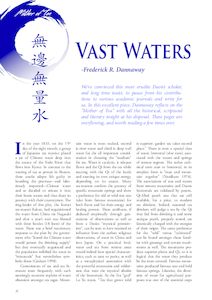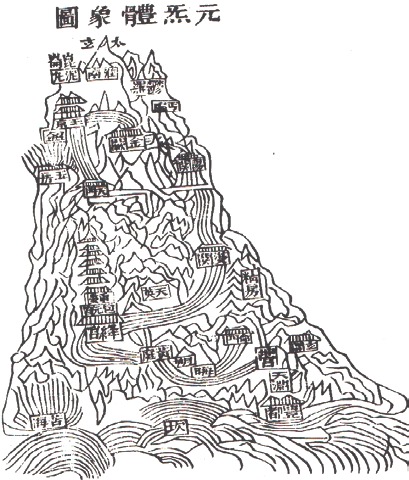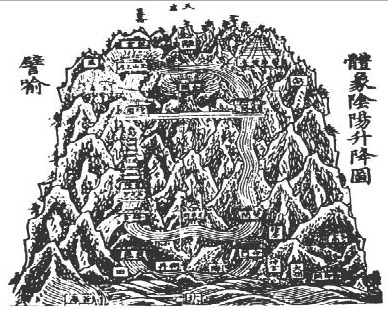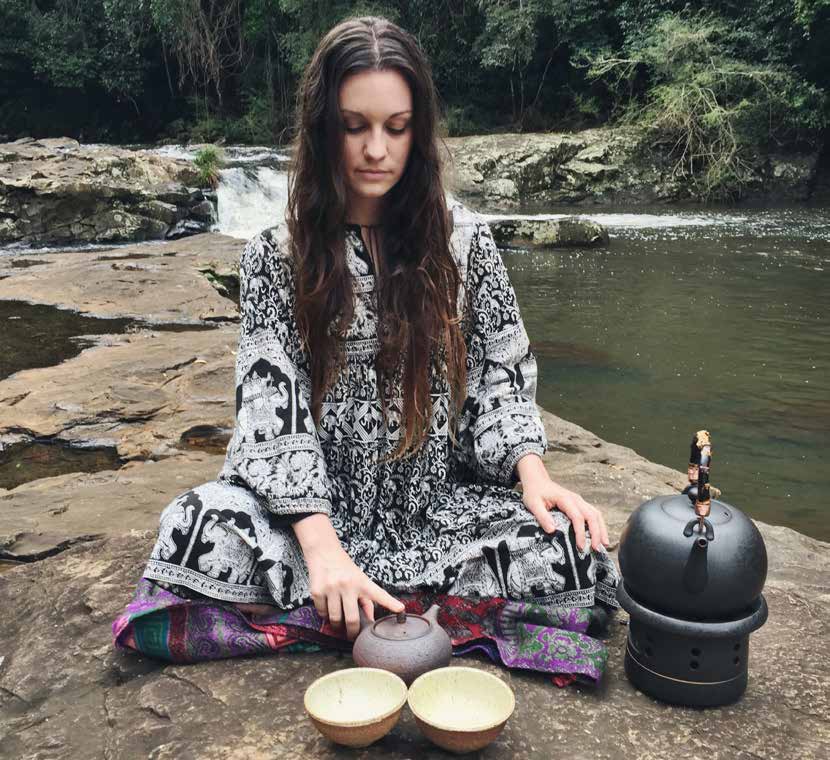
 |
|
In the year 1833, on the 15th day of the eight month, a group of Japanese tea mystics placed a jar of Chinese water deep into the source of the Yodo River that flows into Kyoto. In contrast to the wasting of tea as protest in Boston, these sencha adepts felt guilty in hoarding the precious - and laboriously imported - Chinese water and so decided to release it into their home waters and thus share its potency with their countrymen. The ring-leader of this plot, the literati tea-master Kakuo, had requisitioned the water from China via Nagasaki and after a year's wait was blessed with three bottles (18 liters) of the water. There was a brief reactionary response to the plan by the government who "feared the Chinese water would poison the drinking supply" but they eventually acquiesced and the population imbibed the water in "minuscule" but nevertheless symbolic doses (Graham 1998).
Connoisseurs of tea and tea literature meet frequently with such seemingly eccentric exploits of water obsession amongst tea sages. Mountain water is most exalted, second is river-water and third is deep well water for the all important consideration in choosing the "medium" for tea. Water is catalytic, it releases flavor and the Qi from the tea while reacting with the Qi of the kettle and exerting its own unique energy, depending on its source. Many tea-masters confirm the potency of specific mountain springs and show a preference for old or wild-tree teas (also from famous mountains) for both flavor and for their energy and healing powers. These attributes, if deduced empirically through generations of observations as well as from a Daoist "mystical primitivism", can be seen to have retained an influence from the earliest religious observations, of water in China and into Japan. On a practical level, water and tea from remote areas would indeed have special characteristics, such as taste or purity, as well as a metaphysical association with the powerful mountains and wilderness that were the mystical abodes of the Immortals. As the Tea "god" Lu Yu states, "Tea that grows wild is superior; garden tea takes second place." There is even a special class of water, Immortal (shui xian), associated with the waters and springs of remote regions. The rather technical term xian or Immortal, in its simplest form is "man and mountain together" (Needham 1974). The associations of teas and waters from remote mountains and Daoist Immortals are validated by potent, Qi-filled puerh teas that are still available, for a price, to modern tea drinkers. Indeed, seasoned tea drinkers will judge a tea by the Qi they feel from drinking it and some antique puerh, properly stored, are kinetically charged with the energies of their origin. The same preference for the "wild" versus "cultivated" can be found amongst those familiar with ginsengs and certain mushrooms as well. The mountains produce superior plants and Qi, so it is logical that the water they produce be the most coveted. Famous mountains produced famous teas and held famous springs. Likewise, the diversion of water for agricultural purposes was one of the essential steps of "civilization" which in its best sense is analogous to the cultivation of inner energies of alchemy, or "turning the water wheel."
The myth of the legendary emperor Shennong, likely from a tribe of the same name practicing swidden agriculture, is credited with discovering the Leaf in his taxonomic research on behalf of the starving, poisoned and uncivilized masses (Dannaway 2009). As the story goes, he was boiling water for sanitary reasons when a few tea leaves fell from a gust of wind into the water, which was perhaps a gourd container. If such legends extend to a prehistory before pottery and metallurgy then water might have been heated in bamboo or in gourds. In light of the cosmological and horticultural myths of China with the bottle gourd, treated with utter mastery by Girardot (1986), one might speculate that the primitive tribesman used stones heated in the fire and placed in the bottle gourd to boil water, perhaps making it the first "kettle." Many of the alchemical stills of Daoists were traditionally gourd shaped as well.
When it comes to water, I bow before the pure-flowing channels of the Min.
A tea master like Lu Yu had such a sophisticated palate that he could determine with almost supernatural accuracy the origin of freshly drawn water. Hearing of the exceeding quality of the rivers of Nanling in Yangzi, Lu Yu and a friend dispatched a faithful servant to obtain the precious water. Upon tasting it, Lu Yu judged the water as drawn from the banks, and not from middle of the river as desired. He eventually elicited a confession after exactly determining which parts of the collected water in the jar came from certain parts of the river. The bewildered servant conceded that he spilled some and replaced it with the water of the riverbanks. Such anecdotes are common among tea masters and serve to highlight the fanatical attention to detail that went into making their holy libation.
The spiritual dimension of Lu Yu's tea cannot be underestimated, and he clearly abhorred the vulgar "popular" tea culture that had no religious roots. Tea was a medicine and a sacrament at once healing and allowing communication with oneself and divinities.
The metaphysical qualities of water were certainly considered by tea masters as well, and their symbolic expressions can be found amongst the teaware and in scrolls hung in alcoves. On Lu Yu's brazier legs, for example, there was the inscription "k'an (water) above; sun (wind) below and li (fire) in the middle." In the windows on the rather ornate brazier there were grids. On one grid was a pheasant, a fire bird with the trigram li. On the second grid there was a small tiger whose trigram is sun or wind. The third grid was graced with a fish, trigram k'an as a water creature. As Lu Yu wrote, "sun rules the wind, li rules the fire, k'an rules the water. Wind can stir up the fire and the fire can boil water. This is why the three trigrams are on it."
The spiritual dimension of Lu Yu's tea cannot be underestimated, and he clearly abhorred the vulgar "popular" tea culture that had no religious roots. Tea was a medicine and a sacrament at once healing and allowing communication with oneself and divinities. The reverence for brewing tea must be placed into an exceedingly ancient culture of elixir alchemy, macrobiotic potions and magical plants. Daoist cosmology permeated Chinese thought and the elemental theory based on the trigrams held deep spiritual significance for the cycles of Nature and of the fundamentals of reality itself. Tea, brewing in water atop a fanned fire, has a deeply alchemical relationship with the elements that corresponds to the internal organs in sympathy with the elemental energies. As the outer-alchemical arts evolved into internal visualizations, a beverage like tea would have remained an exoteric link to the past.
Daoist theories certainly spread to Japan with the tea seeds brought by Buddhist priests and Daoist fortune tellers associated with various cults. Rikyu's traditions mention such associations, such as the advice, "In winter start the kettle at 4am, the Hour of the Tiger." While Rikyu would have no doubt preferred famous mountain waters, he was practical in accepting well-water for his tea. But these were subject to Daoist/Buddhist considerations:
Always use water drawn at dawn for tea, whether the gathering be in the morning, at noon, or at night. This is a matter of the alertness of the practitioner of Chanoyu - of making ready sufficient water for the whole day's tea from dawn into night. Just because it is a night gathering does not mean one uses water drawn after noon. During the period from dusk to midnight Yin prevails; water's spirit subsides, poisons are present. Dawn water belongs to the beginning of Yang, when its pristine spirit surfaces; it is the 'flower of the well.' This water is vital for tea and demands careful attention on the part of the practitioner.


As Hirota (1995) notes of spiritual water-drawing, "Seikasui [is] a Buddhist term for water drawn from 2 to 4 AM. This water is considered especially pure for compounding medicines and for altar offerings." Elsewhere (Hirota 1995) Rikyu, based on traditions written after his death, alludes to "secret matters of Yin and Yang" but as to what he meant exactly would be speculation. So while Rikyu's obsession with details are no doubt part of a Zen practice of hyper-alertness and single-mindedness, there are intriguing suggestions of a much deeper esoteric, oral transmission.
A 19th century tea-adept in Japan, Ogawa Kashin apparently dictated oral transmissions on his death bed that were published as Korakudo's Talks on Tea Drinking. As Graham (1998) describes, the preliminary sections deal with practical matters such as teaware and boiling of water while the remaining three correspond with the three abovementioned elements of fire, water and wind. Like the Vedic veneration of the Soma plant as a god, Kashin believed that the leaves of sencha were a "living entity for which systematic preparation methods existed in Nature" that were revealed through a "ritualistic presentation method for sencha that adhered to the principles of and respected the elements - Yin and Yang (in-yo) fire, water and wind - which regulated the natural order of the universe and the calendar." (Graham 1998) Kashin wrote that the teapot "contained the essence of Heaven and Earth" and explains the trigrams on Lu Yu's brazier and its meaning to tea mystics:
Drinking tea invigorated the body, but the spirit could only be harmonized with the universe when quietly seated besides a brazier observing the convergence of the natural forces in the tea. As the wind picks up, the fire burned hotter. The fire caused the water to boil, and then, as these essential elements were synchronized, their natural rhythms brought forth the true flavor of the tea (Graham 1998).
The harmony of utensils, the selection of proper fuel for the fire, the source of the water and tea all combine under the subtle skill of the master to produce the "world in a bowl of tea." But water's role in tea, especially in Japan, was not confined to the kettle and teapot. From deft and defiant flowering arrangements of morning glories to the sprinkling of the roji path to give the sensations of coolness in the heat of summer, water is a rich symbol and aesthetic medium in the hands of tea masters.
Like the rules of hospitality in the arid deserts of Arabia, water is everywhere a symbol of hospitality. In the tea garden, the role of water and hospitality are inseparable; from the water in the basin, to spiritually and physically refresh, to the cups of hot water sipped between rounds of tea. All these were advised upon as crucial for the student to understand, not for the blind observance of rules, but to impress the degree of concentration that a host must summon to render himself utterly hospitable to his guest. As Rikyu said, "Concerning the water in the stone basin, it is wholly the cleansing of the heart and mind that is crucial to the Way." Water washes away the red dust of the world and conducts the tea's fragrant power into the soul, allowing the supreme truth of perfect tea to emerge. This is truly the Way to the tea of "no host, no guest."
Care was taken lest the water boil too quickly, too slowly, or for too long a time. Lu Yu's well-known descriptions for the stages of boiling water are: the first boil, "like the eyes of fishes and with a distant voice." The second boil, was like "a bubbling spring around the edges like a string of pearls." The third boil was like "the crashing of breakers upon the shore" and any further heat would exhaust the water's Qi. Salt might be added to "sweeten" the water and when the boil reaches the second stage "one should withdraw a ladle of water, set it aside, and then stir the center with bamboo chopsticks (Soshitsu 1998)." This water could be added to the again boiling water later after tea had been added, directly, and then by reducing the boil again one could "Nurture the flower of the tea" (Soshitsu 1998). Tea adepts in Japan adopted similar practices in Chanoyu (literally "hot water for tea") as water is changed from the kettle, which was prepared for the gatherings the night before. As it heats "only part of the water" is exchanged "or it will boil too slowly" (Sadler 1998).
Other designations for the stages of boiling are variations such as "shrimp eyes" for bubbles on the water's edge, "crab eyes" for bubbles from below, and "dragon water" for the large bubbles of the rolling boil. Experts note ways to determine the nature of the boil in a time before thermometers that describe three major and fifteen minor ways. The three major ways are the aforementioned designations of the shape and size of bubbles in relationship to the shape of a shrimp, crab or fish eye. The minor methods deal with the sounds of the churning, shaking and whooshing and then silence of a deep boil. The rest of the minor methods entail observations of steam "threads" that are one, two, three, four or intertwining until yielding to the straight upward steam of a serious boiling. Other treatises warn of "old man water" which is water boiled too much at the expense of its Qi (not to mention oxygen). Cai Junmo of the Song Dynasty expressed a preference for "young hot water" versus "old hot water" for similar reasons.

Rikyu's comments above on the spirit of water and its relationship to the "Hour of the Tiger" speak about traditions that came into Japan from ancient China. The powerful Qi-filled water of the mountainous abodes of dragons and Immortals was the most sought-after. But even mountain water was subject to grading by tea masters. Gently rippling water amongst rocks was thought to be the best while turbulent, violent water was to be avoided. No doubt, these energies were thought to affect the body by their peculiar environment in which the waters were collected. Lu Yu cautioned against drinking mountain water that flowed to the ground with no outlet and counseled that waters should be drawn as far away as possible from human habitation. He advised that well water, if it had to be used, should be drawn from the depths or that other waters be let to flow and "drain off" before use. He also cautioned that from the 7th to 9th months there could be toxins present from dragons (Soshitsu 1998).
In Japan, there were special tea ceremonies held when particulary potent or famous water was available called "meisui-date" and the water was always to be served in a special, unfinished "bucket" called a tsurube. Dragons hold a special significance for Buddhists, Daoists and tea alchemists as potent symbols of the power of the watery and fiery realms. The nagas of India, the long of China and ryu of Japan are mythological creatures that represent the earth's energies. Associated with mystics and hidden terma treasures and sutras, as well as power plants and mountain demons, the snakedragon entities have an often ambiguous relationship with humanity. They are the source of power but potentially of toxins as well in metaphors that capture the dual nature of a precarious existence, especially in ancient China. Waters drawn from the deep regions could be powerfully medicinal or deadly poisonous. Such is the power of the Primordial Dao as described in the 7th chapter of Chuang Tzu, which refers to the t'ai-ch'ung, which is a "particular stage of returning to an identification with the Dao (Girardot 1986). " The dark abyss of primordial waters and the reptilian creatures that issue from them are depicted as spirals and snakes that perhaps eventually evolved into the alchemical ouroboros. For an enlightening discussion on dragons, water and the Japanese kappa spirits see Eiichiro (2009).
Girardot's magisterial etymological survey links this with Chapter 4 of the Dao De Ching's context of chung as the sense of an empty container (gourds and kettles), and the relation to the word yuan as "bottomless pool" and chan "deep" or "clear as water" which suggests an allusion to the watery, chaotic conditions of the primordial Dao. This is the cosmogenic chaos of the primordial epochs of undifferentiated potential expressed in the Dao De Ching with such terms as hao-haohan-han or the "moist embryonic mystery" cognate with "vast expanses of water." Confucian, as well as Mencius', attacks on the Daoist notion of an idyllic golden age often use such terms as "the waters in their wild course" (chiang shui) that deluged the world, bringing snakes and dragons which together pushed humanity into a desperate refuge in caves. But the mystical counter-culture of certain Daoist and Buddhist sects embraced the chaotic powers of the wild, of mountains and dragons as a way of connecting back to the primal unity. The wild aghoris, mahasiddas, wild yamabushi and Zen lunatics of various traditions all understand the energy of the "ultimate source" which emphasizes the "mundane" concerns of choice of water (i.e., simply purity and taste).

As external alchemy evolved into internal alchemical arts, the body became increasingly identified as a microcosmic representation of the world. The inner landscapes followed similar winding courses and waterways as the Yellow Springs that were thought to feed all of the water in China. The alchemical conjunction of opposites with water (the abysmal k'an) and the fire (the clinging li) express symbolism employed in feng shui, alchemy and the bedroom arts of Daoist macrobiotic practices. Their respective trigrams are "Yin without and Yang and Yang without and Yin" and are complimenting and completing in the alchemical fusion.
There is deep significance that these two trigrams in alternating positions should complete the I-Ching's permutations in the 63rd and 64th hexagrams. The 63rd hexagram Chi Chi (After Crossing the Water) has water in its proper place above the fire, bodes good fortune and heralds the cycle complete (as in crossing the water), only to begin again with the final hexagram and the repeating from the beginning. The 64th hexagram Wei Chi inverts the position and connotes "Before Crossing the Water" and the vexation of "a young fox trying to keep its tale." In Daoist alchemy the process involves cultivating and blending the Yin and Yang energies into the inner cauldron to achieve a balance of the essences of water and fire. In tea, as in alchemy, the fire must be controlled lest the water boil too hot and become exhausted or too slightly rendering its heat impotent. The water must be pure and undefiled while balanced with the fire in proper proportion or the results will be too strong or bitter or too weak to awaken the flavor of the tea.
Lu Yu's writings have a subtle esoteric dimension as do his symbols on his teaware. As discussed above, the legs of the brazier expressed the elements of fire, wind and water. Scholars note the brazier's resemblance to the Ding used for ceremonies and formal sacrifices to the gods. His devoutly Buddhist upbringing and displeasure at the vulgar use of tea cast him solidly in the alchemical tradition that replaced the furnace with the incense burner or kettle and brazier. The simple, elegant instruction of the sage encodes the most profound truths of Nature, Reality and Tea, which, as Lu Yu would agree, are one and the same. The perfect cup of tea, like the "great work" of alchemists, is essentially the harmony of the elements in dynamic balance.
Water is a most precious resource that is all too often taken for granted, especially in the West. As the news and environmental scientists release report after report of toxic levels of pharmaceuticals and industrial chemicals even in filtered drinking water, we more and more realize that the situation is dire. From the waters that quench thirsty tea plants to the water in the pots and kettles, the tea drinker has both a practical and spiritual imperative to vocalize the need to be stewards of water, the very foundation of life.

